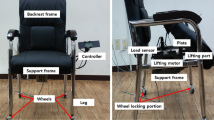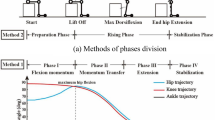Abstract
When healthy people promptly rise from supine to stand (STS), their contraction of leg muscle squeezes blood from the lower limbs to the chest, increasing venous return and contributing to a compensatory increase in blood pressure in order to compensate for gravitational effect. This research aims to design a new device of NMES whose sequence of electric stimulation is bottom-up alternation to simulate natural exercise of SMP. This research illustrates that the innovative Neuromuscular Electrical Stimulation is more efficient at increasing BP and faster activates skeletal muscle pump than the existing one. Furthermore, according to the outcome of Likert scale, the new device is more suitable for scenario of subjects carrying out Supine-to-Stand. It provides subjects with more comfort and convenience.
Access this chapter
Tax calculation will be finalised at checkout
Purchases are for personal use only
Similar content being viewed by others
References
Rubenstein, L.Z., Josephson, K.R.: The epidemiology of falls and syncope. Clin. Geriatr. Med. 18(2), 141–158 (2002)
Mehr, D.R., Fries, B.E., Williams, B.C.: How different are VA nursing home residents? J. Am. Geriatr. Soc. 41(10), 1095–1101 (1993)
Freeman, R., Wieling, W., Axelrod, F.B., Benditt, D.G., Benarroch, E., Biaggioni, I., Gibbons, C.H.: Consensus statement on the definition of orthostatic hypotension, neurally mediated syncope and the postural tachycardia syndrome. Clin. Auton. Res. 21, 69–72 (2011)
Smith, J.J., Porth, C.M., Erickson, M.: Hemodynamic response to the upright posture. J. Clin. Pharmacol. 34(5), 375–386 (1994)
van Dijk, N., Boer, M.C., De Santo, T., Grovale, N., Aerts, A.J., Boersma, L., Wieling, W.: Daily, weekly, monthly, and seasonal patterns in the occurrence of vasovagal syncope in an older population. Europace 9(9), 823–828 (2007)
Gupta, V., Lipsitz, L.A.: Orthostatic hypotension in the elderly: diagnosis and treatment. Am. J. Med. 120(10), 841–847 (2007)
Romme, J.J., Reitsma, J.B., Go-Schön, I.K., Harms, M.P., Ruiter, J.H., Luitse, J.S., van Dijk, N.: Prospective evaluation of non-pharmacological treatment in vasovagal syncope. Europace 12(4), 567–573 (2010)
Shibao, C., Grijalva, C.G., Raj, S.R., Biaggioni, I., Griffin, M.R.: Orthostatic hypotension-related hospitalizations in the United States. Am. J. Med. 120(11), 975–980 (2007)
Herr, R.D., Zun, L., Mathews, J.J.: A directed approach to the dizzy patient. Ann. Emerg. Med. 18(6), 664–672 (1989)
Medow, M.S., Stewart, J.M., Sanyal, S., Mumtaz, A., Sica, D., Frishman, W.H.: Pathophysiology, diagnosis, and treatment of orthostatic hypotension and vasovagal syncope. Cardiol. Rev. 16(1), 4–20 (2008)
Sarasin, F.P., Louis-Simonet, M., Carballo, D., Slama, S., Junod, A.-F., Unger, P.: Prevalence of orthostatic hypotension among patients presenting with syncope in the ED. Am. J. Emerg. Med. 20(6), 497–501 (2002)
Pasek, J., Stanek, A., Pasek, T., Sieron, A.: Physical medicine as an opportunity for improving the health state of patients with vascular diseases (angiopathies). Acta Angiol. 18(3), 93–98 (2012)
Araki, C.T., Back, T.L., Padberg, F.T., Thompson, P.N., Jamil, Z., Lee, B.C., Hobson, R.W.: The significance of calf muscle pump function in venous ulceration. J. Vasc. Surg. 20(6), 872–879 (1994)
Kan, Y.M., Delis, K.T.: Hemodynamic effects of supervised calf muscle exercise in patients with venous leg ulceration: a prospective controlled study. Arch. Surg. 136(12), 1364–1369 (2001)
Broderick, B.J., O’Briain, D.E., Breen, P.P., Kearns, S.R., ÓLaighin, G.: A pilot evaluation of a neuromuscular electrical stimulation (NMES) based methodology for the prevention of venous stasis during bed rest. Med. Eng. Phys. 32(4), 349–355 (2010)
Corley, G.J., Breen, P.P., Bîrlea, S.I., Serrador, J.M., Grace, P.A., ÓLaighin, G.: Hemodynamic effects of habituation to a week-long program of neuromuscular electrical stimulation. Med. Eng. Phys. 34(4), 459–465 (2012)
Nådland, I.H., Walløe, L., Toska, K.: Effect of the leg muscle pump on the rise in muscle perfusion during muscle work in humans. Eur. J. Appl. Physiol. 105(6), 829–841 (2009)
Acknowledgments
The authors would like to thank the Ministry of Science and Technology in Republic of China for financially supporting this research under Contract no. MOST 104-2420-H-006 -018 -MY3.
Author information
Authors and Affiliations
Corresponding author
Editor information
Editors and Affiliations
Rights and permissions
Copyright information
© 2018 Springer International Publishing AG
About this paper
Cite this paper
Wu, FG., Chen, XA. (2018). Medical Device Design for Improving Orthostatic Hypotension During Supine-to-Stand (STS). In: Duffy, V., Lightner, N. (eds) Advances in Human Factors and Ergonomics in Healthcare and Medical Devices. AHFE 2017. Advances in Intelligent Systems and Computing, vol 590. Springer, Cham. https://doi.org/10.1007/978-3-319-60483-1_64
Download citation
DOI: https://doi.org/10.1007/978-3-319-60483-1_64
Published:
Publisher Name: Springer, Cham
Print ISBN: 978-3-319-60482-4
Online ISBN: 978-3-319-60483-1
eBook Packages: EngineeringEngineering (R0)




